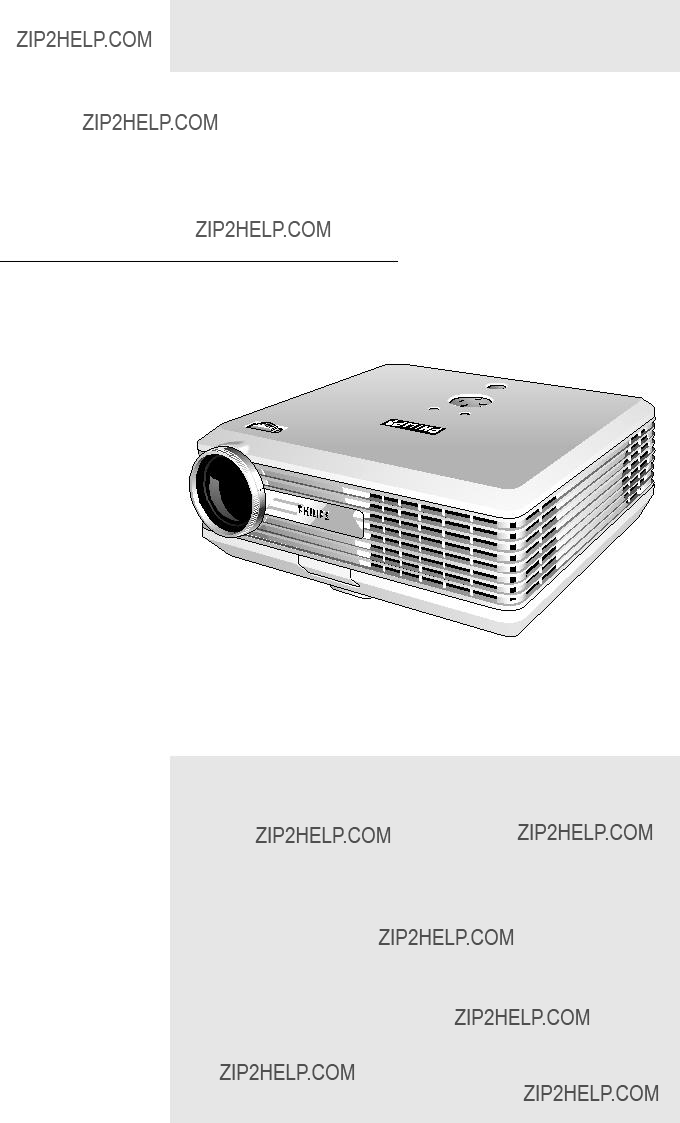
Philips multimedia projector
bCool XG1
English User guide

Philips multimedia projector
bCool XG1
English User guide
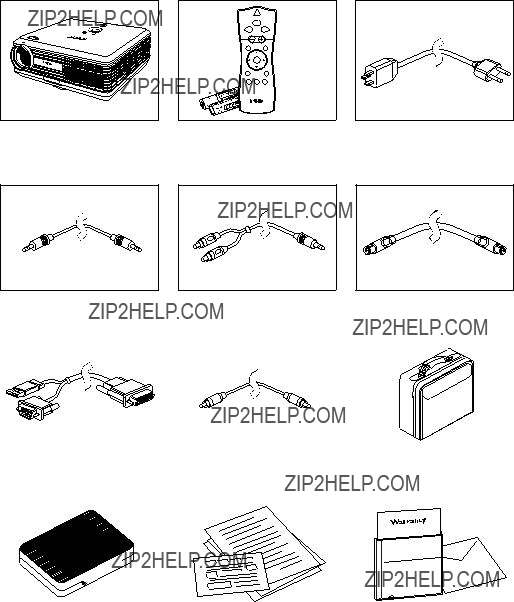
1. Introduction>
Congratulations on your purchase of one of the most sophisticated and reliable products on the market today. We are sure that, used properly, it will bring you years of enjoyment.You will want to keep this manual handy, as it is a convenient source of information about your projector.
For your own protection and prolonged operation of your projector, please read the enclosed Safety Sheet.
Packaging contents Please confirm that the following items are packed in the projector box.They are provided to help you use or set up your projector.
Optional accessories The following accessories are available via the dealer from which you purchased your Philips projector:
???LCA3125/00 - 180W replacement lamp - 8670 931 25009
???LCA2218/00 - Ceiling mount - 8670 922 18009
???LCA5317/00 - RCA/M1 component video adaptor cable - 8670 953 17009
???LCA5318/00 - DVI + USB/M1 adaptor cable - 8670 953 17009
Service accessories The following accessories are available via our Service organisation only:
???Laser pointer remote Control - 3139 228 62631
???Compact remote control - 3139 228 62641
???User Guide (Cd- rom) - 3122 435 91181
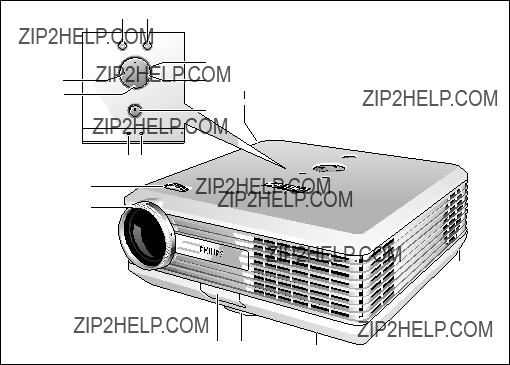
Menu 1
OK 2
Cursor Control 3
Auto Image 4
Standby/ Standby indicator 5
To activate and deactivate the menu.
To confirm actions in the menu when the menu is on screen.
When the menu is active the Cursor Control controls the menu cursor to navigate through the OSD menu.The cursor control works with up/down and left/right button operation.
To automatically adjust frequency, tracking, horizontal and vertical position. With most signal sources, Auto Image provides the best results
To switch the projector in or out of the Power/Standby mode.
The Standby indicator (text on button/ring around button):
In Power on mode:
???blinks green when the projector is warming up;
???lights up green when the projector is in Power On mode;
In Power off mode:
???lights up red when the projector is in Standby mode;
???blinks red when the projector is cooling down.
Temperature indicator 6 Lights up red in case of temperature error.
Lamp indicator 7 ??? Fast blinks red (0.5 sec On, 0.5 sec Off) when lamp start has failed.
???Fast blinks red (1 sec On, 1 sec Off) in case of fan error.
Source 8 To select the current projection source (Auto, Computer, DVI,YPbPr,YCbCr, RGBS,
Zoomring 9 To adjust the size of the projected image.
Focus ring 0 To adjust the focus of the projected image.
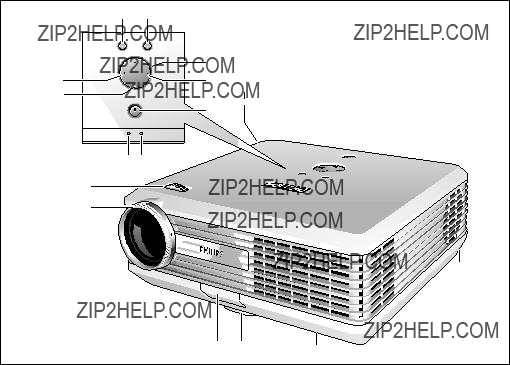
Mains inlet socket !
Elevator button @
Elevator foot #
Lamp compartment $
To connect the projector to the mains.
To adjust the vertical angle of the projector.
Horizontal adjuster % To adjust a possible oblique displayed picture.
 Keystone corrections To correct picture distortion of the vertical keystone type by internal scaling.
Keystone corrections To correct picture distortion of the vertical keystone type by internal scaling.
keys  ^
^
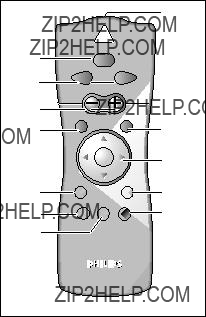
@
6
!
2
3
4
8
5
6
Stand by
0
9
1
7
Laser pointer remote control
Stand by On 1 To switch the projector in or out of the Power/Standby mode.
Mouse Left/Right 2 Function as the Left and Right mouse keys of your pc when USB connection has been made.
??? Volume + 3 To adjust the volume.
Menu 4 To activate and
Source 5 To select the current projection source (Auto, Computer, DVI,YPbPr,YCbCr, RGBS,
A(udio)/V(ideo) Mute 8 To mute the sound of the projector and to mute the picture.
Cursor Control 9 To manipulate the mouse cursor on the connected computer as long as the menu is not active. When the menu is active the Cursor Control controls the menu cursor to navigate through the OSD menu.The cursor control works with up/down and left/right button operation.
Note The Cursor Control can only function as a mouse cursor when the projector is connected to the USB connector of the computer. Windows 98, Windows ME, Windows 2000 or Windows XP should be installed on the computer when you make the USB connection.
OK 0 To confirm actions in the menu when the menu is on screen.
Laser ! To activate the laser pointer to indicate items on the screen.
Note:The laser pointer sends out a laser beam. Do not look into this beam!
Laser pointer @ Exit point of laser pointer.
Note The maximum range of the remote control is approximately 7 m (?? 25 feet).
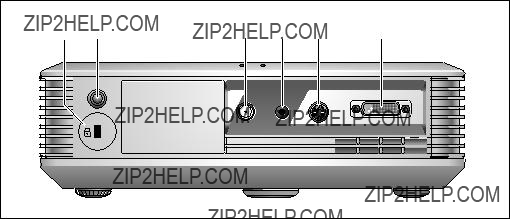
Data source connections
???Input socket to connect to the digital (DVI) Data out terminal of a computer.
???
???Input socket to connect to DVD- and
This socket can be connected to the following output sockets:YCbCr, YPbPr, RGBS (Composite sync), RGBHV).
Video source connections
This socket can be connected to a
Video 4 Input socket to connect to the Video out socket of a video recorder, Laser Disc player, video camera, DVD player, or TV with AV output socket.
This socket can be connected to CVBS output sockets.
Other connections
Audio in 3 Input socket to connect to the Audio out terminal of a computer, video recorder, laser disc player, video camera or TV with A/V output socket.
IR sensor 5 To receive the signals from the remote control.
Lock slit 6 To insert an optional locking device (Kensington lock).
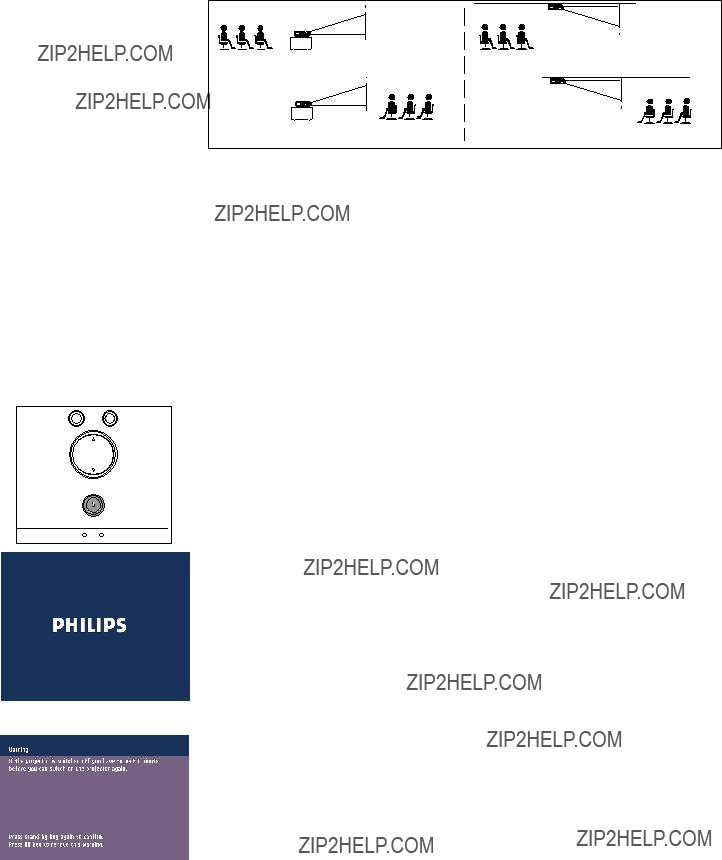
Positioning the projector and screen
Switching on the projector
MenuOK
Source 
 Auto Image
Auto Image
Notes
Philips Multimedia Projector
???Place the projector on a stable, level surface, out of direct sunlight and away from sources of excessive dust, dirt, heat, water, moisture, vibration and strong magnetic fields.
???Allow sufficient cooling of the product by keeping all air inlets and outlets clear from obstructions.
???Position the projector in such way that the viewers cannot watch into the projector light beam.
???Choose a screen size suitable for the number of viewers and the size of the room.
???Picture quality is best when you sit directly in front of the projector screen.
???The projector can be used for both front projection, rear projection and ceiling projection applications. As default factory setting, the projector has been set up for front projection.You
can change to rear or ceiling projection via the ???Mirror??? function in the ???Setup??? menu.
???For more information on the projection properties of the projector, check the Projection Assistant application on the
1Insert the mains lead into the projectors Mains inlet socket and connect it to the wall socket.
??? The Standby indicator lights up red, the projector is now in the Standby mode.
2Remove the lens cap.
3Press the Standby button on projector or remote control to switch on the projector.
???The Standby indicator starts blinking green, the projector is now warming up.
???When the projection lamp is on, the Standby indicator lights up green after the
4 Press the Standby button twice to switch the projector back into the Standby mode.
???The Standby Warning screen will appear for 20 seconds.
???The projector will now go into Standby mode.
5 To switch off the mains supply completely, disconnect the mains lead.
???Save energy! Please put the projector in the Standby position if you are not going to use the projector for more than 15 minutes.
???When no signal inputs are detected for 15 minutes, the projector automatically switches to Standby (Auto Standby). This setting can be changed in the Features menu
???Before disconnecting the mains lead, make sure that the cooling fan has stopped (about 1 minute after the projector has been switched to Standby).

Zoom ring
Focus ring
Adjusting the vertical and horizontal angle of the projector
A
B
C
To raise the projector
1Press the Elevator button (A).
2Raise the projector to the desired display angle, then release the button to lock the elevator foot (B) into position.
3Use the horizontal adjuster (C) to
To lower the projector
1Press the Elevator button (A).
2Lower the projector to the desired display angle, then release the button to lock the elevator foot (B) into position.
3Use the horizontal adjuster (C) to
Keystone correction If projector and screen are not properly placed, the picture will be distorted, producing a keystoned image (picture top width larger than picture bottom width or vice versa). When a keystoned image occurs the 4:3 ratio will still be guaranteed.This is especially important when the projector is being used together with an ???intelligent whiteboard???.
???Keystone correction??? allows you to correct picture distortion of the vertical keystone type by internal scaling.
???Use Keystone  to widen the image.
to widen the image.
???Use Keystone  to narrow the image.
to narrow the image.
This correction function is also accessible through the ???Keystone??? option in the ???Setup??? menu of the On Screen Display (OSD) menu.

Note The maximum range of the remote control is approximately 7 m (?? 25 feet).
General information Computer input
The computer input is suitable for both Apple Macintosh computers (Power Book and Power Mac) as well as for IBM compatible PCs.The projector is Microsoft (R),Windows (R) 95/98/ME/2000/XP compatible and accepts input signals from all computers that meet following specifications:
???Multi scan
???Horizontal scan rate:
???Vertical refresh rate:
???Bandwith: 140 MHz
???Display Data Channel DDC: 2B
Analog (VGA) connection
The data (VGA) output of IBM compatible PCs can be connected directly to the Data in socket of the projector using the VESA
Digital (DVI) connection
The Data in socket also allows digital connection to your computer, resulting in the highest possible picture quality. For this an optional VGA/DVI adaptor is required.
USB connection (Universal Serial Bus)
The VESA
Mouse control:
By connecting the projector to the USB (downstream) port of the computer, the mouse function on the Remote Control automatically gets installed.
You can now manipulate the mouse cursor on the computer and on the screen, using Cursor Control on the remote control.The Mouse Left/Right keys on the remote control function as Left and Right mouse keys of your pc.
Theft deterrence
The SecurityMax??? application, supplied on the
Note Based on the specific hardware and software configuration available, Apple Macintosh computer users could experience incomplete or erratic USB
Video input
The projector accepts the input signal of all major video formats, including NTSC 3.58, 4.43, PAL B, G,
D, H, I, N, M, SECAM and HDTV (480i/P, 576P, 720P, 1080i) signals.The projector will recognize these standards and adapt to them automatically.With the ???Picture format??? feature you can select one of five picture format options 4:3, 16:9, letter box, pan & scan or 4:3 original screen.
CAUTION Always switch off projector and external equipment before making any connections.
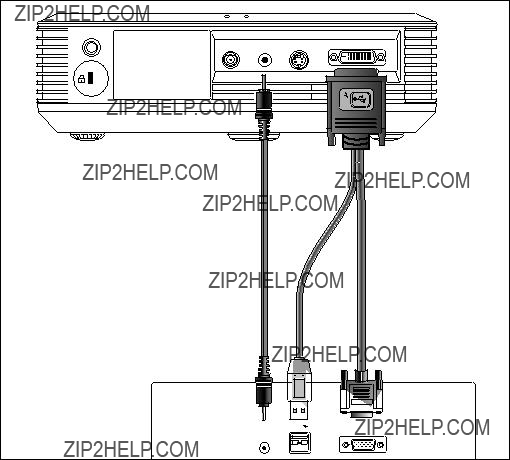
PC/Macintosh 1 Connect connector 1 of the VESA
2Connect connector 2, to the Data (out) socket of the computer.
3Connect the USB connector (3) to the USB (downstream) socket of the computer.
??? You can now manipulate the mouse cursor on the computer and on the screen, using Cursor Control on the remote control. When using the USB connection, make sure
Windows 98, Windows ME, Windows 2000 or Windows XP is installed on the computer.
???The display settings of the computer will be changed to fit the capability of the projector.
???If required you can connect the Audio out socket of the computer to the Audio in socket of the projector.
For this, use the Audio minijack to minijack cable (4) supplied.
??? Audio information from the Computer will then be played via the projector speaker.
??? When switching on, first switch on the projector and then the PC.
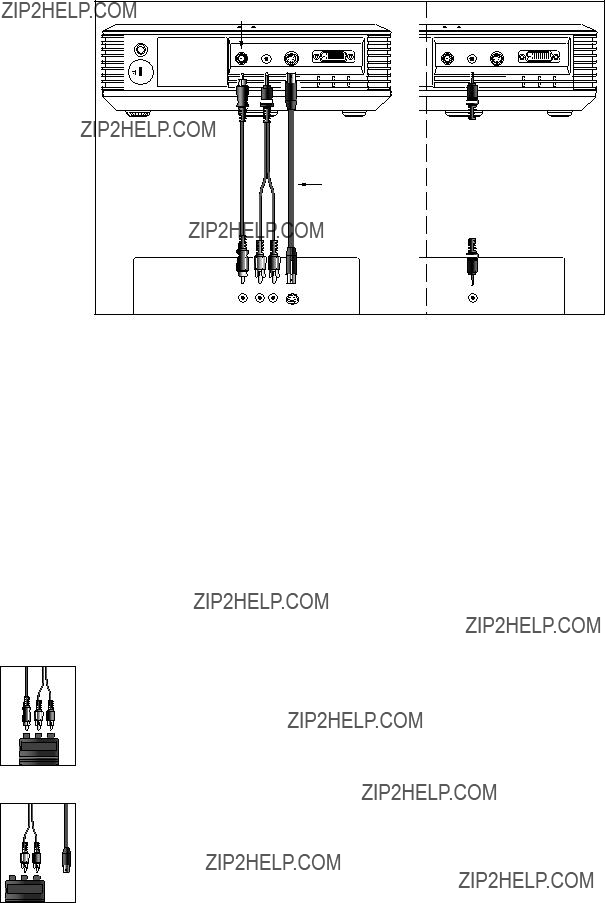
4. Installation Connecting to video equipment >
CVBS only
CVBS only 
2Connect the Audio out L/R sockets of the VCR, Laser Disc player, video camera or TV to the Audio in socket of the projector.
For this, use the Audio minijack to RCA cable (2) supplied.
For this, use the
2Connect the Audio out L/R sockets of the
For this, use the Audio minijack to RCA cable (2) supplied.
If your video equipment has only a single audio output:
???Connect the Audio out socket of the video equipment to the Audio in socket of the projector, using the Audio minijack to minijack cable (4) supplied
Scart connection CVBS (Video)
1Connect an optional Scart/RCA Audio Video adapter to the Scart connector of the VCR, Laser Disc player, video camera or TV.
2 Plug the Composite video cable supplied into both the adapter and the Video (in) socket of the projector.
3 Plug the Audio minijack to RCA cable supplied into both the adapter and the Audio in socket of the projector.
1Plug the
2 Connecton an optional Scart/RCA Audio Video adapter to the Scart connector of the VCR, Laser Disc player, video camera or TV.
3 Plug the Audio minijack to RCA cable supplied into both the adapter and the Audio in socket of the projector.
Scart adapter (not for USA version)
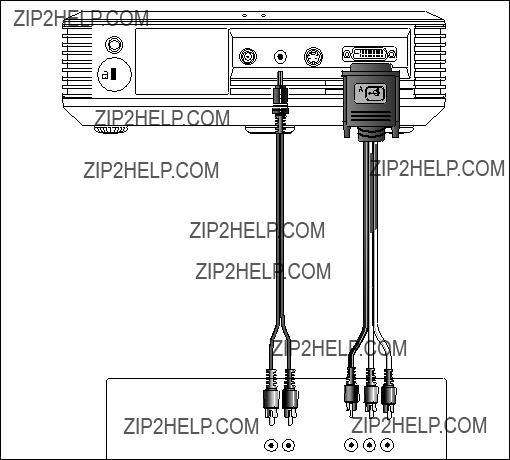
4. Installation Connecting to video equipment >
Component/HDTV
Equipment
3b
DVD player, Settop Box,
HDTV receiver, ect.
Component/HDTV YPbPr,YCbCr
1Connect an optional RCA/M1 component video adaptor cable (1) to the Data in socket of the projector.
2Connect the plugs at the other end of the cable to the appropriate output sockets of your Component- or
???If required you can connect the Audio out L/R sockets of the Component- or
For this, use the Audio minijack to RCA cable (2) supplied.
???Audio information from the Component- or
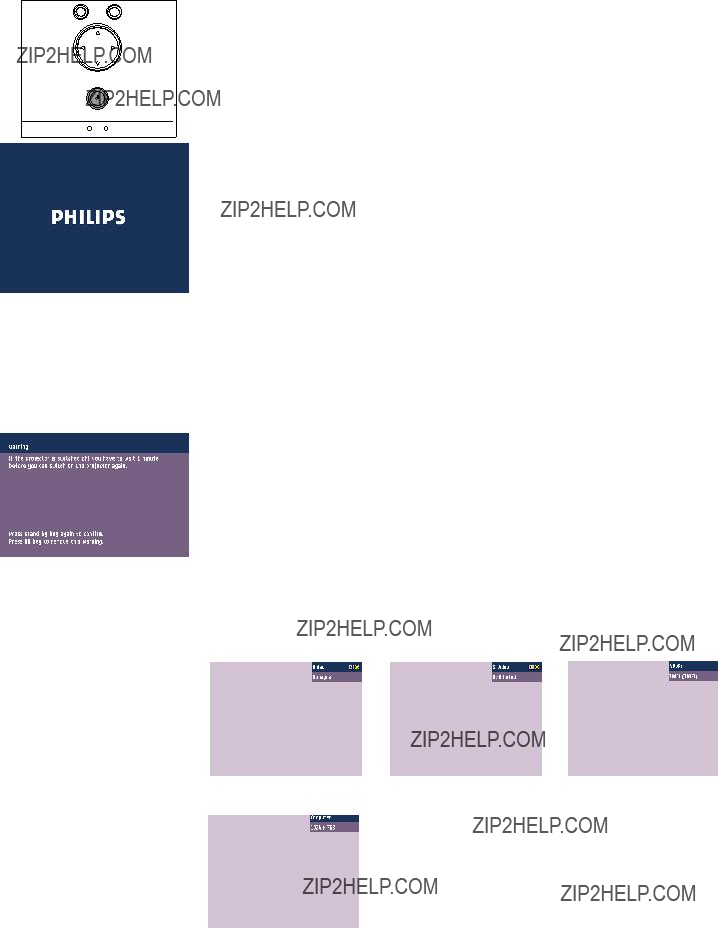
???When the projection lamp is on, the Standby indicator lights up green after the
2Select the required source (Auto, Computer, DVI,YPbPr,YCbCr, RGBS,
Note When only one input source is connected, this source will automatically be selected (Auto Source). When more input sources are connected, the source with the highest priority will be selected (Computer, DVI,YPbPr,YCbCr, RGBS,
3 Switch on the computer or start video playback.
???A feedback message appears on the screen, indicating the selected source.
Messages General explanation
Messages are displayed in the centre of the screen.The problem is described in the header of the message display. Suggestion(s) to solve the problem are displayed in the lower part of the message display.These messages cannot be suppressed.
Feedback messages
Feedback messages are displayed in the top right corner of the screen.They are displayed when:
???a signal comes up or goes down;
???when an input source is changed;
???when A/V Mute is activated.
Some examples
These messages will only be displayed when the menu option ???Feedback??? is set to ???On??? in the ???Setup??? menu. All messages will be removed automatically after 4 seconds.
Computer selected as source
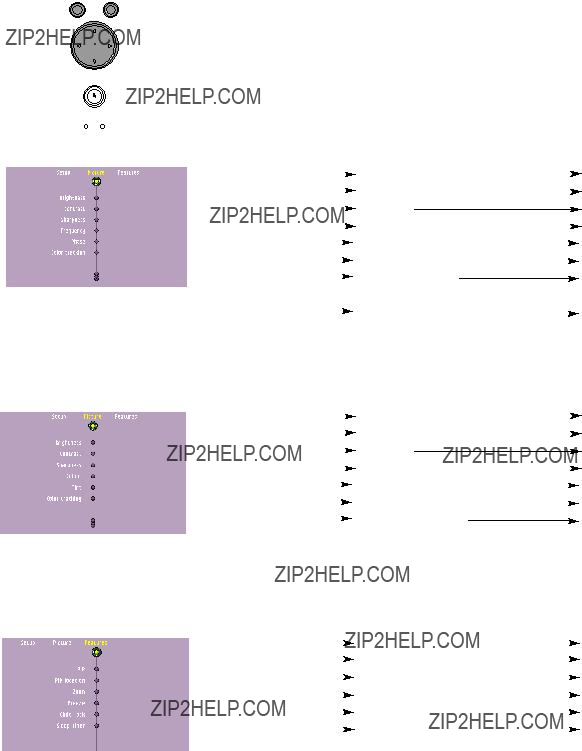
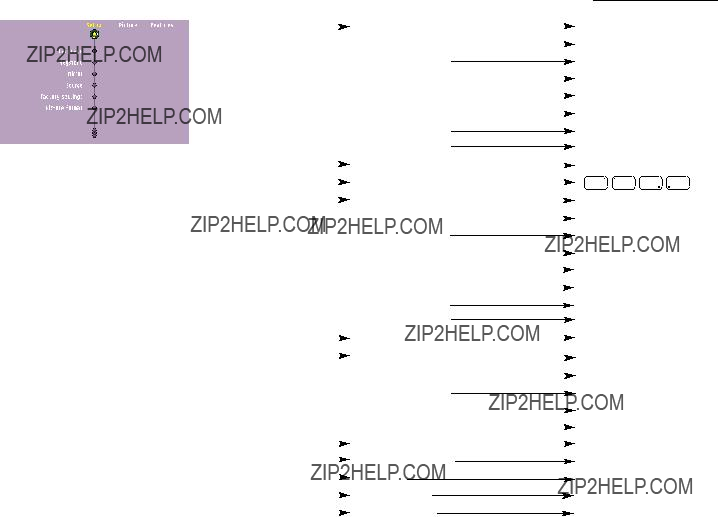
AB
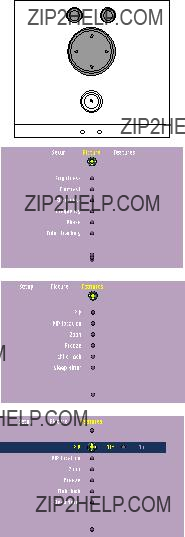
???The menu bar appears on the screen.
2 Use Cursor Control left and/or right to move the cursor to any other item in the menu bar.
3 Use Cursor Control Down to enter sub menu.
4Select the sub menu item to be adjusted using Cursor Control up and/or down. When more items are available than can be shown in one screen, move the cursor down to go to
the next list of items. When you want to go back to the first list, move the cursor up.
5Adjust the selected item, using Cursor Control left and/or right.
6Select the next item to be adjusted in the sub menu and adjust as described above.
7Press Menu to close the On Screen Display.

Computer adjustments For computer signal input, the following ???Picture??? adjustments can be made.
MenuOK
Source 
 Auto Image
Auto Image
Picture adjustments
???Press Menu and select ???Picture??? in the menu bar.The following ???Picture??? adjustments can now be made according to the instructions under ???General explanation???:
???Brightness
adjusts brightness of the displayed picture;
???Contrast
adjusts the overall contrast intensity;
???Sharpness
controls the contour impression of the picture:
???Frequency
changes the display data frequency to match the frequency of your computer???s graphic card. If you experience a vertical flickering bar, use this function to make an adjustment.
???Phase
minimises picture imperfections. When connecting the projector to your PC for the first time, be sure to adjust the phase control for optimal readability of the projected text;
???Colour tracking
adjusts the degamma settings. Adjustment of the setting will change the colour performance of the display;
???Colour Temperature
adjusts the colour temperature.The higher the temperature the cooler the screen will look.The lower the temperature the warmer the screen will look.
???Auto sync
automatically adjusts frequency, tracking, horizontal and vertical position. With most signal sources, Auto sync provides the best results.
Video series adjustments For YPbPr,YCbCr, RGBS,
Picture adjustments
???Press Menu and select ???Picture??? in the menu bar.The following ???Picture??? adjustments can now be made according to the instructions under ???General explanation???:
???Brightness
adjusts brightness of the displayed picture;
???Contrast
adjusts the overall contrast intensity;
???Sharpness
controls the contour impression of the picture:
???Colour
adjusts a video image form black and white to fully saturated colour;
???Tint
adjusts the colour balance of red and green;
???Colour tracking
adjusts the degamma settings. Adjustment of the setting will change the colour performance of the display;
???Colour Temperature
adjusts the colour temperature.The higher the temperature the cooler the screen will look.The lower the temperature the warmer the screen will look.
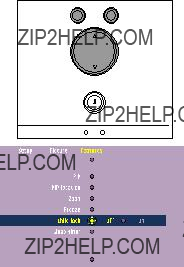
General adjustments
MenuOK
Source 
 Auto Image
Auto Image
Features adjustments
Press Menu and select ???Features??? in the menu bar.The following ???Features??? adjustments can now be made according to the instructions under ???General explanation???:
???PIP (Picture In Picture)
switches the PIP window on and off. PIP enables projection from a second source in the currently projected computer or component video picture.The currently projected computer or component video picture can also be used as input source.
Please note that the second source can only be displayed in the PIP window when the main screen is displaying a computer or component video source (or no source at all). Any invalid combination will result in a black PIP window for the main screen has priority.
???PIP location
selects the location of the PIP window in the main screen;
???Zoom
enlarges a part of the picture. Use Corsor control to select the zoom centre and select the required zoom factor: 1 x, 4 x, 9 x or 16 x.
???Freeze
captures a moving picture (still picture);
???Child lock
???Sleep timer
switches Sleep timer mode off or selects the delay time after which the projector automatically switches to Standby.

MenuOK
Source 
 Auto Image
Auto Image
Setup adjustments
???Press Menu and select Setup in the menu bar.The following Setup adjustments can now be made according to the instructions under ???General explanation???:
???Language
selects the required menu language;
???Keystone
corrects picture distortion of the vertical keystone type by internal scaling;
???Mirror
mirrors the picture for use of the projector in various positions with respect to the user(s) and the projection screen;
--Source
selects the current projection source (Auto, Computer, DVI,YPbPr,YCbCr, RGBS,
???Factory settings
resets all user settings to the default factory settings;
???Picture Format
selects one of five picture format options (4:3, 16:9, letter box, pan & scan and 4:3 original).
Due to the scaling of the image when the picture format is changed, it might be possible that a part of the actual image is missing at the top or the bottom of the screen. With Cursor Control you can adjust the position of the projected image upwards or downwards.
???Volume
adjusts the sound level;
???System information
the System Information sub menu contains an overview of the most relevant projector settings, including information on the hardware and software configuration;
To suppress OSD messages. Warning or error messages however are never suppressed.
--Lamp counter
To show the operating time of the lamp, which can be reset after a new lamp has been installed;
--SmartDimmer
switches on the power saving mode by reducing the lamp power from 180W to 150W. When SmartDimmer is switched on (150W), the audible (fan) noise will be reduced and gray scales in the picture are optimized. When SmartDimmer is switched off (180W), peak brightness in the picture is obtained. Default setting for data and component sources (Data in) is Off; default setting for video sources (Video,
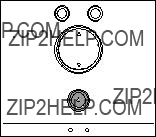
Cleaning
Caution
MenuOK
Source 
 Auto Image
Auto Image
Switch off and disconnect the projector before cleaning.
1Press the Standby button twice to switch off the projector.
??? The Standby indicator starts lights up red.
2Wait until the cooling fan has stopped (about 1 minute after the projector has been put in Standby) and disconnect the mains lead and all other cables.
Cleaning the cabinet
??? When the cabinet is dusty, clean it by gently wiping with a soft cloth.
???A chamois leather slightly moistened with water is sufficient for cleaning the housing.
???Do not use cleaning agents as they may harm the housing.
Cleaning the lens
???When the lens is dirty or dusty, first blow the dust off and then gently wipe with a soft brush or lens cleaning paper. Never touch the lens with your fingers.
???The lens is likely to become mouldy if left dirty.

Lamp
Lamp Replacement
MenuOK
Source 
 Auto Image
Auto Image
When operation time reaches the last 1400 hours of the average lamplife, the message ???Lamp life has almost exceeded??? will be displayed on the screen, When operation time reaches 1500 hours, the message ???Lamp life has exceeded??? will be displayed.
The lamplife remaining can be checked using the OSD menu.
1Press Menu.
2Use Cursor Control to move the cursor to ???Setup???.
3Use Cursor Control to select ???Lamp counter???.
1Switch off the projector and wait until the lamp has cooled down before disconnecting the projector. Remove the mains lead from both projector and wall socket.
A
B
B
B
B
2 Press tab A and remove the lamp door.
3Unscrew the screws B.
4Grasp the lamp holder handle and carefully pull the lamp holder out of the projector.
??? Do not tilt. If the inner tube is broken glass particles may fall out.
???Keep lamp holder opening to your right. Do not touch lamp or point lamp holder opening at anyone.
5 Carefully remove the new lamp housing from its package.
???Always use the same type of lamp: See ???Optional accessories??? for the correct type of lamp for your projector.
???Do not touch lamp or point lamp housing opening at anyone.
???Do not drop, as the impact may cause the lamp to break.
6Place the lamp holder in the guiding slots and insert into the lamp compartment.
7Tighten screws B again.
A
8Put the lamp door back in place and press tab A back in its original position.
9Insert the mains lead into both the projector Mains inlet socket and the wall socket.
10Press the Standby button to switch on the projector.
11Reset the lamp life time (see ???Resetting the lamplife time???).
12Dispose of the old lamp in special chemical disposal bins.
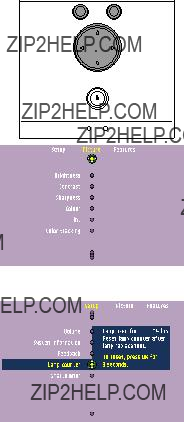
???The menu bar appears on the screen.
2Use cursor control to select ???Setup??? in the menu bar.
3Use cursor control to select ???Lamp counter??? in the sub menu.
4Press OK to reset the lamp counter.
5If required, select another item you wish to adjust or press Menu to exit.

Warning Under no circumstances should you try to repair the projector yourself as this could invalidate the guarantee.
Read as follows
Problem
Image is not or incorrectly displayed
??? Possible cause
???Solution
General
???Mains lead is not correctly connected.
??? Correctly connect mains lead.
???Lamp holder cover is not closed correctly or the lamp holder is damaged.
???Close the cover correctly (see ???Lamp replacement??? under ???Maintenance???).
???Signal cable not correctly connected.
??? Connect signal cable correctly.
???The projector is in Off position.
???Press Standby to switch on the projector.
??? A/V Mute active.
???Cancel A/V Mute.
In Video series mode
???Keystoning is applied on a high resolution component signal.
???Decrease keystoning until the image is correctly displayed. For this use the ???Keystone??? option in the ???Setup??? menu.
In Data mode
--Partial, scrolling or incorrectly displayed image.
???Use the ???Autosync??? option in the ???Picture??? menu.
???Input resolution is too high (and keystoning is applied).
???If you wish to keep the keystone correction, decrease the input resolution until the image is correctly displayed. For this, refer to the User Guide or support information of the computer.
???If you wish to keep the input resolution as it is, decrease keystoning until the image is correctly displayed. For this, use ???Keystone correction??? option in the ???Settings??? menu.
???Input resolution is too high (and no keystoning is applied).
???Decrease the input resolution until the image is correctly displayed. For this, refer to the User Guide or support information of the computer.

Image is blurred
Picture rolls
No sound
The projector does not react to commands from the remote control
Indicators
???Image is not focused.
??? Adjust focus ring.
???Distance between projector and screen is not correct.
???Adjust the distance between the projector and the screen.
???Signal cable is not correctly connected.
??? Connect signal cable correctly.
???Signal cable is not correctly connected.
??? Connect signal cable correctly.
???Audio cable is not correctly connected.
??? Connect audio cable correctly.
???Volume is not adjusted properly.
???Adjust volume.
???
???Cancel
???Distance is too great.
??? Reduce distance.
???Batteries are exhausted.
???Replace batteries (see ???Inserting the batteries in the remote control???).
??? IR sensor is obstructed.
???Remove obstacle.
Lamp indicator
???Red blinking (0.5sec. On, 0.5sec. Off): lamp start has failed.
???Disconnect projector from the mains. Reconnect and restart. If this does not solve the problem, replace the lamp. See ???Maintenance.???
???Red blinking (1sec. On, 1sec. Off): the fans are locked.
???The projector will automatically shut down. If this problem persists, contact service center.
Temp. (temperature) indicator
???Lights up red: temperature error.
???Disconnect projector from the mains. Reconnect and restart. If this does not solve the problem, contact your service centre.
Standby indicator (text on Standby button/ring around Standby button)
???Lights up green: Power on mode.
???Green blinking: warming up in Power on mode.
???Lights up red:: Standby mode.
???Red blinking: cooling down in Power off mode.
??? ???Windows??? did not manage to install the driver correctly. In this case the ???Device manager??? will contain a catagory ???Other devices.
??? Disconnect the projector.
??? Remove all items listed under ???Other devices??? in the ???Device manager???.
??? Restart the computer.
??? Reconnect the projector.